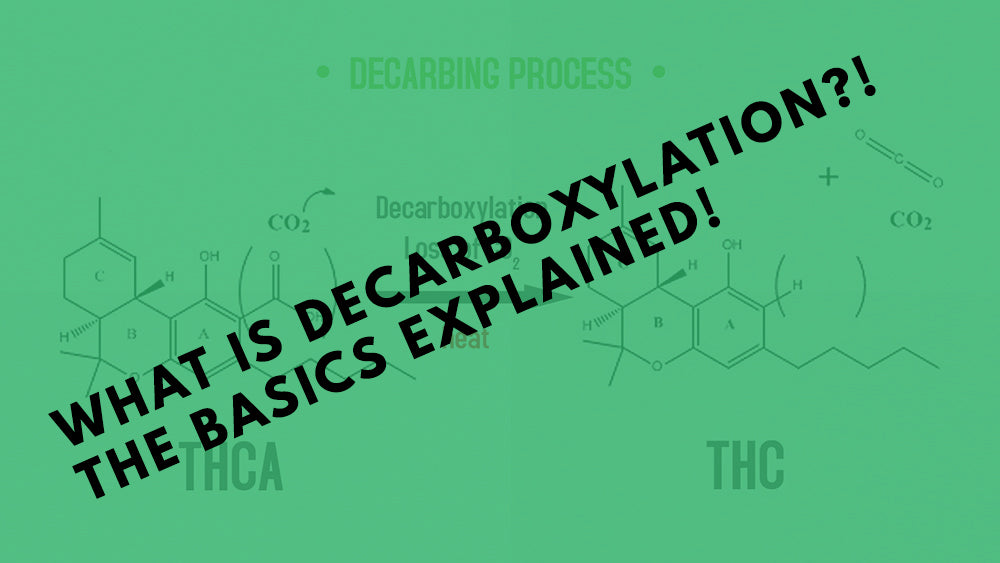
If you don’t know yet, cannabis, when consumed after curing,
does not give you that high. While the active ingredient is there, you need to “activate” it to unlock the potential.
Cannabis contains tetrahydrocannabinolic acid, or THCa, which is a
cannabinoid found in small quantities in the plant. It is a non-psychoactive component of cannabis that gives the health benefits, such as anti-inflammatory solutions. But when the acid dries up, THCa becomes Tetrahydrocannabinol, or THC, which handles inducing the psychoactive effects that recreational users often look at.
Now, to unleash this potency, you need to heat the cannabis, which removed the acidic properties of THCa, and becomes THC. This heating process, often done at low temperatures for a while, is called Decarboxylation.

What is Decarboxylation?
Decarboxylation prepares your cannabis to trigger the effects of THC.
By heating the cannabis over time, you get to unleash the potency of your strain by turning the THCA into THC, as well as activating the cannabidiol, which enables the psychoactive effects and medicinal benefits.
You can think of Decarboxylation as a frozen slab of steak in your freezer that you want to cook.
You can sear it as it is, and fail to unlock the best flavors, or defrost, which results in better flavors when cooked.
Drying and curing after harvest over time will cause a partial decarboxylation to occur. That is why some cannabis flowers also
test for the presence of small amounts of THC along with THCA.
Smoking and the use of vapes instantaneously decarboxylates cannabinoids due to the extremely high temperatures of these apparatuses, making them instantly available for absorption through inhalation.
If edibles are your preferred method, heating cannabinoids at a lower temperature over time allows us to decarboxylate the cannabinoids while preserving the integrity of the material we use so that we may infuse it into what we consume.
How Long Is The Decarboxylation Process?
The THCa in cannabis begins to decarboxylate at approximately 220 degrees Fahrenheit after around 30-45 minutes of heating. Full decarboxylation may need more time to occur, but it may differ depending on the strain.
It is recommended to decarb at lower temperatures for a much longer period in an attempt to preserve terpenes. At higher temperatures, the terpenes may burn and result in undesirable results and flavor.
The integrity of both cannabinoids and terpenoids are compromised by using temperatures that exceed 300 degrees F, which is why temperatures in the 200’s are recommended. That is why it is recommended that rosin pressing is done around 190 to 220 degrees Fahrenheit at most.
Remember also that strains behave differently. What temperature works for one might need less for another strain.
How do you Decarboxylate?
There are four (4) methods to decarboxylate your cannabis, mostly using common household materials: using an oven, a mason jar, sous vide, or with a slow cooker or double boiler.
Using Your Oven

The quickest way to do this is with your oven. You can set your home oven to 200-230 Fahrenheit, lay a piece of parchment paper or baking sheet on a baking tray.
Like baking, you want uniform sizes, so they all decarb at the same time. Having bigger and smaller nugs mixed with each other may cause some to burn quicker while others will not.
You may want to try grinding your herbs so that it has consistent shape and surface area to lay thin and flat over the parchment paper.
This process can take anywhere from 30-45 minutes but might be longer, depending on how much you have.
Tha Mason Jar Technique

The mason jar technique requires you to have a mason jar with a lid, baking tray, kitchen towel, oven gloves, and an oven.
Then set your oven between 220 to 240 degrees Fahrenheit. While heating your oven, break your cannabis to the size of a rice grain, then put it in the mason jar and lightly screw the lid back.
Dampen the kitchen towel and lay it over the baking sheet. Put the filled mason jar on the towel, which prevents the jar from falling.
Put the baking tray inside the oven and bake for an hour. Set an alarm every 15 minutes to carefully take out the mason jar and shake it to disperse the cannabis evenly.
After an hour, you can take out the jar from the oven and let it cool down for half an hour before using it for cooking or storage.
Sous Vide Method
The third method for decarboxylation is the sous vide method. That is an almost fool-proof way of decarbing your cannabis, although it can be more expensive, as an immersion circulator can go for $100.
But if you often do decarboxylation, the sous vide method will be worth it, given the outlay for the circulator.
For this method, you will need an immersion circulator, a large pot or plastic tub to hold the circulator, and a vacuum sealer or zip-top freezer bag.
To begin, fill up your tub or pot with hot tap water, following the instructions set by the manufacturer of the immersion circulator. Set the circulator to 203 degrees Fahrenheit.
Grind your cannabis into fine pieces so that you can maximize surface area.
Fill the plastic bag and lay it as flat and tight as possible to remove air pockets. Put the bag into the water bath and let it stay there for 90 minutes.
Once the 90 minutes are up, gently take out the bag and let it cool to room temperature for 15 – 20 minutes. Then, dry the bag and take out the decarboxylated cannabis, and store it in a container for use later on.
Using Fat

The fourth and final method in this article using fat or oil for decarboxylation.
You can use a slow cooker and infuse your cannabis with plant-based oil such as coconut or olive oil, or tools like herbal infusers.
Just mix your cannabis with your preferred oil in a mason jar and put it in a double boiler or slow cooker with hot water and let it heat at low temperatures for eight (8).
This method works best, when within the proximity of people who do not like the smell of cannabis.
Conclusion
Decarboxylation is a process that many take for granted. While it is relatively simple to do, the process is just as crucial as harvesting your buds properly. You do not want to damage it, but you need to be patient to get the best results.




